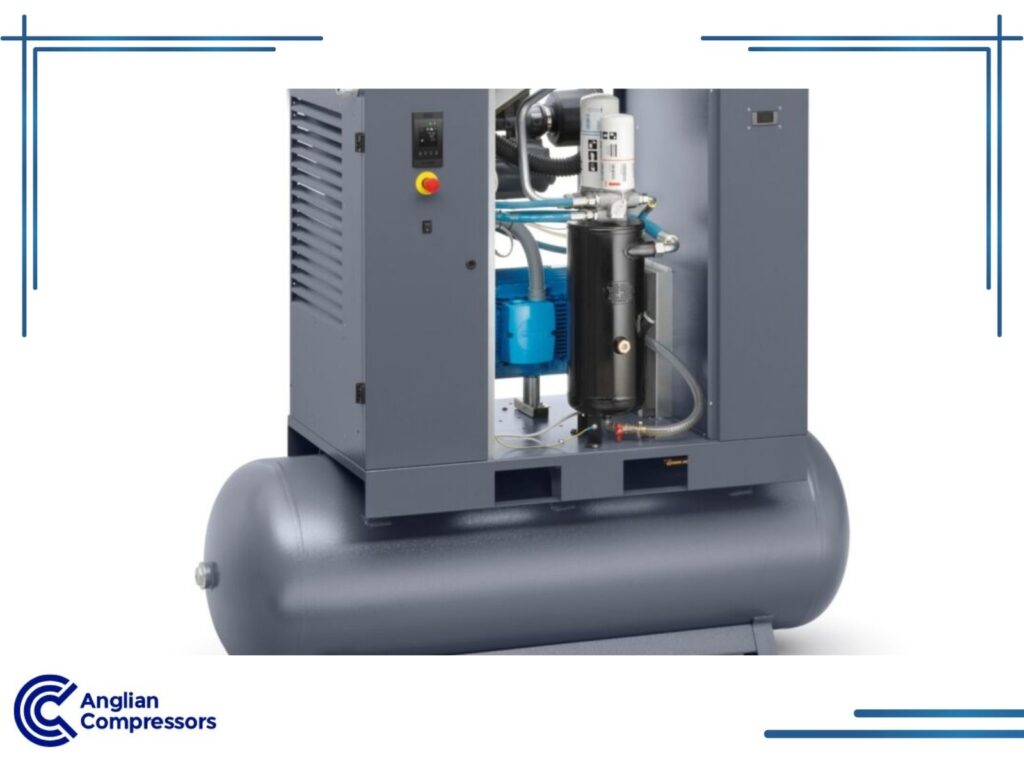Compressor Connectivity
Getting unexpected compressor breakdowns, rising energy use, and more frequent downtime on your compressors?
Imagine having the tools to prevent downtime, reduce energy costs, and enhance productivity – all at your fingertips. Compressor connectivity makes this possible.
Imagine a world where you could predict maintenance needs, optimise energy consumption, and remotely control your entire compressed air system from your phone.
That’s what compressor connectivity is all about!
New technologies like compressor connectivity are key to remaining competitive and minimising losses. This innovation is revolutionising how we manage and optimise compressed air systems across all industries. In applications where precise air quality, pressure, or flow rate is critical, even slight fluctuations can cause costly production delays. In circumstances where a production line relies on particular air quality, pressure or flow rate from compressed air, unobserved fluctuations from standard levels can result in line shutdowns.
Understanding Compressor Connectivity
Air compressor connectivity links your compressed air system to a remote monitoring solution, providing real-time visibility and enabling smarter control. Plant managers can track compressor performance, receive alerts, and adjust settings directly from mobile devices or desktop dashboards.
Sensors installed on the compressor collect information such as pressure, temperature, and energy usage. This data is transmitted to a central plant management system, helping you optimise performance and reduce energy consumption.
Cellular connectivity is a form of remote connection that offers reliable transmission speeds without the need for many relay nodes or complex infrastructure. It is particularly effective in industrial operations where traditional network setups might not be practical.
Platforms like Atlas Copco UK’s SMARTLINK or Quincy Compressor’s data monitoring system offer advanced insights that support predictive maintenance and help achieve maximum uptime. Whether you are managing one unit or an entire compressor room, remote connectivity makes it easier to monitor the performance of your equipment from anywhere.
This technology is central to Industry 4.0 and the shift toward smart factories. It enhances compressor control, reduces downtime associated with manual checks, and helps businesses stay connected to critical compressor operations.
You do not need to replace existing equipment either. Retrofit kits and connectivity upgrades enable legacy machines to integrate with modern connection systems, allowing new connectivity features to work across older fleets.
Why Compressors Are Getting “Smart”
The Internet of Things (IoT) is a buzzword for connected technology, the idea that the internet should connect all your things together.
Initially, it was a fanciful idea. However, global spending on IoT-compatible technologies has skyrocketed, and now even compressors can be connected to the internet. Modern compressors equipped with smart sensors can identify operating issues, detect inefficiencies, and trigger alerts in real time.
Newer air compressors are now packed with sensors. These pick up on operating errors, unexpected deviations from the norm, and faulty part issues too. This allows plant managers to respond proactively, preventing issues before they disrupt operations.

Benefits of Using Connected Air Compressors
Whether there’s a single air compressor installed in the plant, or several machines situated in a compressor room, it’s necessary to know how they’re functioning without constant manual intervention.
Here are a few benefits of connected air compressors:
- Automated Mobile Alerts for Critical Issues through Cellular Conenctivity
Connected compressors monitor their health continuously and send automated alerts for critical issues like temperature surges, pressure drops, or abnormal vibrations. These alerts empower plant managers to act quickly, minimising downtime and avoiding costly repairs. With cellular or Wi-Fi-based notifications, managers can respond from anywhere, improving overall efficiency.
This proactive approach empowers plant managers and maintenance teams to address problems swiftly, often before they escalate into costly breakdowns or production stoppages.
No longer tethered to on-site monitoring, personnel gain the flexibility to manage their responsibilities from anywhere, armed with alerts needed to make informed decisions and take immediate action.
A side benefit of this is that project managers no longer need to be on-site always to effectively manage the operations.
- Prevent Downtime of Essential Equipment
You can avoid unexpected downtime through reliable alerts and notifications from the monitoring equipment. These suggest when a compressor is overheating (perhaps because of an improperly ventilated compressor room) or if something else is wrong with the compressor.
Predictive maintenance is more consistent this way too, because of fewer unexpected breakdowns between maintenance sessions. Emerging issues aren’t immediately pressing, but sophisticated Atlas Copco air compressors flag them to be included in the next maintenance cycle. This approach reduces the time lost to costly machine downtime.
Reliable alerts and notifications from connected systems help detect overheating, blockages, or other issues. For example, Atlas Copco’s connected compressors integrate predictive maintenance features, reducing unexpected breakdowns and optimising maintenance schedules.
- Gain Meaningful Insights and Data Monitoring Systems
Meaningful insights are obtained through a centralised monitoring software. It gathers information received continually from numerous sensors and smart components, filters it, and displays what’s relevant to the manager in a logical, organised manner.
Detailed analysis and actionable intelligence about compressor performance are now possible from the big-picture view down to the granular aspects. Operations are better optimised when managers are presented with the latest, most accurate information on how the plant and its machinery are functioning.
Centralised monitoring systems analyse data from multiple sensors, providing actionable insights for plant managers. These systems filter raw data into meaningful metrics, allowing managers to optimise operations at both macro and micro levels.
- Make Changes to Compressor Setups
Rather than configuring a compressor manually, IoT makes it possible to configure pressure levels, flow rates, and other aspects, on-the-fly.
Compressor connectivity revolutionises the way adjustments are made to compressor setups. Traditionally, reconfiguring a compressor’s parameters required physical access and manual intervention. However, with connected compressors, operators can now make changes remotely and in real-time through intuitive interfaces like mobile apps or web-based dashboards.
This remote access allows for fine-tuning pressure levels, flow rates, and other critical settings optimising compressor performance to match the specific needs of the moment. For instance, if production demands suddenly change, operators can instantly adjust compressor output to meet the new requirements, all without leaving their desks. This not only saves time and resources but also enhances operational flexibility and responsiveness.
Also, by adjusting settings sooner, energy consumption isn’t wasteful because of an incorrect pressure or flow setting that went unnoticed for too long.
With connected compressors, operators can make changes remotely via intuitive dashboards or mobile apps. Whether adjusting pressure levels or modifying flow rates, real-time control reduces energy waste and ensures compressors run optimally.
- Maintain Stronger Adherence to Production Schedules
As a plant manager, you’ll have schedules to maintain. While compressors are expensive pieces of equipment, it’s often true that downtime is far more costly. Also, as the plant manager, to borrow a phrase from the Americans, “The buck stops with you”.
Managing your compressors centrally allows for streamlined scheduling and tighter control over pressure levels. Alerts for pressure deviations ensure swift responses, minimising disruptions and maintaining production timelines.
Managing your compressors centrally allows for the use of weekly timers to set basic parameters around what’s required. Pressure band controls are also useful to ensure proper PSI pressure management.
In a multi-compressor environment, it’s prudent to be extra careful with pressure levels across several compressors to ensure the minimum required pressure is constantly met. Setting alerts to notify when this level is breached allows for a rapid response and adjustment to resolve the matter before production is unduly affected.
Particularly in a multi-compressor installation scenario, the advantages of improved connectivity with centralised control systems cannot be overstated.
- Manage Pressure Drops Quicker, Avoid Production Foul-ups
Sudden pressure drops, where there’s now a difference between the pressure level required and what the air compressor is producing, are a major concern.
Before connected devices, a flashing alert on a small screen near the compressor, along with an audible alert, was the best employees could hope for. If a knowledgeable technician or the plant manager wasn’t on-hand to decipher what the alert meant, frantic phone calls to an on-call staff member were needed. Also, explaining what to do, from a distance, was easier said than done.
Production line shutdowns due to loss of air pressure are now easier to remotely monitor and manage. Immediate pressure level adjustments compensate in the short term until the matter is later reviewed in detail to determine the root cause.
- Improve Energy Efficiency Through Precise Configurations
Energy costs make up most of the operating costs of air compressors. While production downtime is costly, so are non-optimal configurations, too.
Every reduction to the pressure used on site is a saving, however minimal. Air-based tools or other uses for compressed air don’t usually operate more efficiently as a result of the wrong or higher pressure. Therefore, there is no upside potential to excessive pressure levels. More energy is ultimately used as the pressure rate is raised, so it’s best to configure the air compressors conservatively and to track results using the system’s data flow.
Every 1 bar of excess pressure results in a 7% increase in energy consumption. Connected systems help maintain optimal pressure settings, significantly reducing energy waste.
Future Trends in Compressor Connections
The future of air compressor systems is closely linked to the rise of smart industrial operations. As connectivity technology advances, it is transforming how businesses manage compressed air within their facilities.
Artificial intelligence and advanced controller technology are being used to detect early performance issues, enabling real-time monitoring and control. These developments enhance performance and energy management, thereby reducing costs and saving time. For best practice, businesses will increasingly rely on remote compressor connection tools to stay ahead of failures and optimise maintenance schedules.
Manufacturers like Atlas Copco UK and Quincy Compressor are already integrating intelligent software into their equipment. These platforms utilise data transmission from connected components to recommend changes that optimise energy use and minimise air usage across the plant.
Cellular connectivity will continue to expand due to its consistent bandwidth and transmission speeds. It allows for remote monitoring capabilities without the need for complex wiring or internal networks. As a result, more sites can access connection benefits regardless of location or existing infrastructure.
In the near future, more plants will adopt systems that monitor multiple compressors, dryers, and filters from one dashboard. These connected environments represent a new standard for the compressor industry, offering increased visibility, enhanced reliability, and improved control over compressed air assets.
Need Help with Compressor Connectivity?
The industry globally has embraced connectivity in plants and factories to save money, better manage resources, and get the most from their technology. If your UK business is unsure how to reap the full benefits of compressor connectivity, Anglian Compressors, a branch of Atlas Copco, are here to help.
Anglian Compressors, a branch of Atlas Copco, is here to help UK businesses adopt advanced connectivity solutions. We provide tools to enhance your operations, from SMARTLINK-enabled compressors to tailored retrofit kits. Contact us today for expert guidance!
FAQ
How does compressor connectivity work within the compressed air system?
Compressor connectivity uses advanced compressor technology to collect data from sensors within the compressed air system. This information is transmitted using connection methods like Wi-Fi or cellular networks, allowing operators to monitor performance remotely and respond quickly to any issues.
Why use cellular connectivity in industrial air applications?
Utilising cellular connectivity provides a reliable and flexible solution for industrial air systems, particularly in environments where wired networks are limited. It supports remote access, reduces the need for on-site checks, and helps save time and labour across day-to-day operations.
Can connectivity support optimisation in VSD compressors?
Yes. Connectivity plays a key role in the optimisation of variable speed drive (VSD) compressors. Real-time data enables the adjustment of compressor output to match demand, thereby improving energy efficiency and reducing operational costs.


